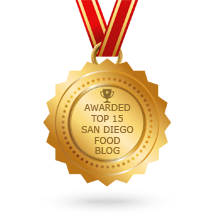I was up in L.A. last weekend on assignment for Sunset Magazine to take in Koreatown's restaurant scene with chef Debbie Lee of Next Food Network Star, Season 5 fame and owner of the Glendale pub grub eatery Ahn-Joo. Before meeting her Saturday night I tooled around the neighborhood on my own, stopping at the large Galleria Plaza on Olympic and Western. This plaza, along with the Koreatown Plaza on Western at 9th, is known for its splendid food court. And the Galleria Plaza is home to the expansive Galleria Market on the ground floor. Well, I'm not about to skip a market opportunity...
In San Diego, I've been a regular shopper at two Korean markets, Zion and First Korean. But having read Lee's cookbook,
Seoultown Kitchen, and gotten more familiar with ingredients, I was more directed than aimless with this market visit. And, it didn't hurt that on a Saturday afternoon, there are free samples galore. So, let me point out several highlights of the market that can translate (to some extent) to our local Korean markets, understanding that I'm just skimming the surface.
One of the ingredients I was looking for was Korean peppers. This is most certainly a staple of Korean cuisine and while they are longer (about four inches), thicker, and smooth, not wrinkled--like a shishito or padron--they have a similar flavor. So, we're not talking crazy heat but great flavor. While you could certainly grill them, my experience with them that day at lunch was raw, sliced, and mixed with a sweetish chile sauce.
In the produce section, there was a lady surrounded by customers getting free samples of half-dried persimmons. Sweet and chewy, they are a wonderful snack even if they're a bit odd looking. And, according to the customers I spoke with, that's all they're meant for.
Around the corner from the produce was a display of bags filled with two kind of unusual crackers. One was peanut rice crackers, which were sweet and crunchy with a touch of salt from the slivers of peanuts, and the other darker crackers were made with beans, and also sweet and crunchy. Again, these are just meant for snacking, perhaps with a cup of coffee.
The seafood section is one of those fabulously classic Asian displays, filled with live crabs, a variety of unusual whole fish, shrimp, and, something I hadn't seen in a supermarket, a case of live abalone. They also had refrigerated packages filled with seafood and other ingredients to make different kinds of stews. So, for instance, if you wanted a no-brainer spicy crab stew, you could pick up this package which not only has crab, but clams, shrimp, sliced peppers, onions, green onions, jalapeños, squash, enoki mushrooms, soy bean paste, and hot pepper paste.
Behind me as I was eying the seafood counter was the scent of something fragrant cooking. I turned around to find a woman working over a saute pan, creating a seafood pancake made with shrimp, mussels, squid, and clams. Also there for tasting were plates filled with cooked mackerel and razor clams with peppers.
That sight eased me into an aisle filled like a cafeteria with banchan--a row of at least 30 prepared side dishes ranging from stir-fried radish stalk and marinated sand lances to fried fishcake, salted octopus, various kimchees, pickled perillar leaves, and seasoned fresh cucumber. This is when I wished I still lived in L.A. and could buy an assortment of these to take home.
I love condiments and the aisles devoted to condiments at Galleria Market were stunning. Sea salt is big in Korean cooking and there were a variety of brands and sizes, up to five pound bags, of sea salt--fine, coarse, roasted, flavored. Something I'll be picking up at a local Korean market to have on hand is a package of red pepper powder. Spicier than paprika, it turns dishes like those cukes above a vibrant red. It's also used with glutinous rice, flour, corn syrup, and salt to make hot pepper paste, which is added to meats, soups, stews, marinades or used on its own as a spicy dip or relish.
Then there are the toasted sesame seeds, both white and black. Put them in marinades, sauces, and add to vegetable sides. They are plentiful on Galleria Market's shelves.
I'll end with dessert. The bakery here has a crazy array of savory and sweet breads and pastries. Lee tells me there's heavy competition for the donuts on a Sunday morning. What I saw, though, led me to believe that there's heavy competition for everything there. The Korean white bread, which reminds me of Japanese white bread, is square and smooth and would be terrific for French toast.
I was charmed by the displays of cakes and these cupcakes. Like Japanese-style French pastries, Korean-style French pastries are less sweet, making it much easier to over-indulge. These are adorable.
Then there are the croissants and other more adult pastries. I was put off by the prepackaging, but in the back of the retail part of the bakery you can see that baked goods are made on site. So, I'm hoping these are fresh. With all the planned dining ahead of me, I didn't buy any to try; you go, and tell me what you think.
I am looking forward to Lee's visiting San Diego so we can hit not just the Korean restaurants along Convoy, but Zion Market. I wonder how it will compare.
Print Page

































